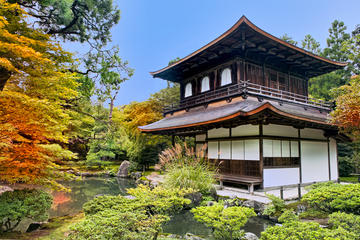Ginkaku-ji Temple (Silver Pavilion)
TIME : 2016/2/22 11:51:35

Ginkaku-ji Temple (Silver Pavilion)
The Silver Pavilion temple in Kyoto’s eastern mountains has no silver on it at all. Legend has it that when Shogun – or military ruler – Ashikaga Yoshimasa built his retirement villa in 1482 on the grounds where Ginkaku-ji stands today, he grandly stated he wanted the entire pavilion covered with silver to imitate the Golden Pavilion (Kinkakuji), built by his grandfather. The villa was converted to a Buddhist temple after Yoshimasa’s death in 1490, and the shining nickname persists today.
The circular route around the Silver Pavilion begins in a dry sand garden, named the “Sea of Silver Sand,” where a cone-like representation of Mt. Fuji has been dubbed the “Moon Viewing Platform.” The grounds open up to a moss garden featuring ponds with islands and short bridges, streams, and a variety of foliage. The path snakes up a hill leading to a viewing point of the entire temple grounds and the city beyond. The path comes full circle with up-close views of the Silver Pavilion itself. Unlike some of Kyoto’s famous temples, none of the buildings at the Silver Pavilion can be viewed from the inside.
Practical Info
City buses 5, 17, and 100 travel directly from Kyoto Station to Ginkaku-ji in about 35-40 minutes for 220 yen ($3USD) one way. Some pilgrims and visitors choose to walk along the Philosopher’s Path; the walk is 30-45 minutes from Nanzen-ji. The temple is open from 8:30am-5:00pm from March through November and 9:00am-4:30pm from December to February, and there are no closing days. The entrance fee is 500 yen ($5USD).
